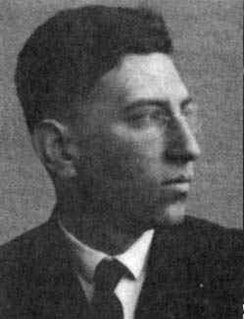In mathematics, specifically in ring theory, the simple modules over a ring R are the modules over R that are non-zero and have no non-zero proper submodules. Equivalently, a module M is simple if and only if every cyclic submodule generated by a non-zero element of M equals M. Simple modules form building blocks for the modules of finite length, and they are analogous to the simple groups in group theory.
In representation theory and algebraic number theory, the Langlands program is a web of far-reaching and influential conjectures about connections between number theory and geometry. Proposed by Robert Langlands, it seeks to relate Galois groups in algebraic number theory to automorphic forms and representation theory of algebraic groups over local fields and adeles. Widely seen as the single biggest project in modern mathematical research, the Langlands program has been described by Edward Frenkel as "a kind of grand unified theory of mathematics."

John Torrence Tate Jr. was an American mathematician, distinguished for many fundamental contributions in algebraic number theory, arithmetic geometry and related areas in algebraic geometry. He was awarded the Abel Prize in 2010.
In mathematics, a global field is one of two type of fields which are characterized using valuations. There are two kinds of global fields:
In algebra, the Wedderburn–Artin theorem is a classification theorem for semisimple rings and semisimple algebras. The theorem states that an (Artinian) semisimple ring R is isomorphic to a product of finitely many ni-by-ni matrix rings over division rings Di, for some integers ni, both of which are uniquely determined up to permutation of the index i. In particular, any simple left or right Artinian ring is isomorphic to an n-by-n matrix ring over a division ring D, where both n and D are uniquely determined.
In mathematics, a Galois module is a G-module, with G being the Galois group of some extension of fields. The term Galois representation is frequently used when the G-module is a vector space over a field or a free module over a ring in representation theory, but can also be used as a synonym for G-module. The study of Galois modules for extensions of local or global fields and their group cohomology is an important tool in number theory.
In mathematics, specifically abstract algebra, an Artinian ring is a ring that satisfies the descending chain condition on (one-sided) ideals; that is, there is no infinite descending sequence of ideals. Artinian rings are named after Emil Artin, who first discovered that the descending chain condition for ideals simultaneously generalizes finite rings and rings that are finite-dimensional vector spaces over fields. The definition of Artinian rings may be restated by interchanging the descending chain condition with an equivalent notion: the minimum condition.
In mathematics, there are several conjectures made by Emil Artin:

Michael Artin is a German-American mathematician and a professor emeritus in the Massachusetts Institute of Technology mathematics department, known for his contributions to algebraic geometry.
In mathematics, Artin–Schreier theory is a branch of Galois theory, specifically a positive characteristic analogue of Kummer theory, for Galois extensions of degree equal to the characteristic p. Artin and Schreier (1927) introduced Artin–Schreier theory for extensions of prime degree p, and Witt (1936) generalized it to extensions of prime power degree pn.
In mathematics, an Artin L-function is a type of Dirichlet series associated to a linear representation ρ of a Galois group G. These functions were introduced in 1923 by Emil Artin, in connection with his research into class field theory. Their fundamental properties, in particular the Artin conjecture described below, have turned out to be resistant to easy proof. One of the aims of proposed non-abelian class field theory is to incorporate the complex-analytic nature of Artin L-functions into a larger framework, such as is provided by automorphic forms and the Langlands program. So far, only a small part of such a theory has been put on a firm basis.
Brauer's theorem on induced characters, often known as Brauer's induction theorem, and named after Richard Brauer, is a basic result in the branch of mathematics known as character theory, within representation theory of a finite group.

Otto Schreier was a Jewish-Austrian mathematician who made major contributions in combinatorial group theory and in the topology of Lie groups.
The Brumer–Stark conjecture is a conjecture in algebraic number theory giving a rough generalization of both the analytic class number formula for Dedekind zeta functions, and also of Stickelberger's theorem about the factorization of Gauss sums. It is named after Armand Brumer and Harold Stark.
In algebraic number theory, an equivariant Artin L-function is a function associated to a finite Galois extension of global fields created by packaging together the various Artin L-functions associated with the extension. Each extension has many traditional Artin L-functions associated with it, corresponding to the characters of representations of the Galois group. By contrast, each extension has a unique corresponding equivariant L-function.

In mathematics, more specifically abstract algebra and ring theory, a noncommutative ring is a ring whose multiplication is not required to be commutative; that is, there may exist a and b in R with a·b ≠ b·a. These include commutative rings as a subclass. Noncommutative algebra is the study of results applying to rings that are not required to be commutative. Many important results in the field of noncommutative algebra apply to commutative rings as special cases. Some authors use the term noncommutative ring to refer to a ring that is strictly noncommutative, that is, for which there do exist a and b in R with a·b ≠ b·a.